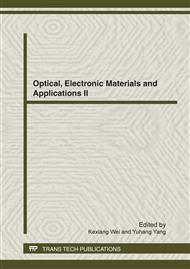[1]
M. Vitali, M. Guidotti, G. Macilenti, C. Cremisini, Phthalate esters in freshwaters as markers of contamination sources—a site study in Italy, Environ. Int. 23 (1997) 337-347.
DOI: 10.1016/s0160-4120(97)00035-4
Google Scholar
[2]
Kaneco, S., Katsumata, H., Suzuki, T., & Ohta, K, Titanium dioxide mediated photocatalytic degradation of dibutyl phthalate in aqueous solution-kinetics, mineralization and reaction mechanism. Chemical Engineering Journal, 125(2006), 59-66.
DOI: 10.1016/j.cej.2006.08.004
Google Scholar
[3]
T.J. Wams, Diethylhexyphthalates as environmental contaminant—a review, Sci. Total Environ. 66 (1987), 1-16.
Google Scholar
[4]
National Primary Drinking Water Regulations, Federal Register, 40 CFR, Part 141, US Environmental Protection Agency, Washington, DC, 1991 (Chapter I).
Google Scholar
[5]
Council Regulation (EEC), No. 793/93 of 23 March 1993 on the Evaluation and Control of the Risks of Existing Substances (OJ L 84, 5 April 1993). European Union, Brussels.
Google Scholar
[6]
Staples, C. A., Adams, W. J., Parkerton, T. F., Gorsuch, J. W., Biddinger, G. R., & Reinert, K. H. Aquatic toxicology of eighteen phthalate esters. Environmental Toxicology and Chemistry, 16(1997b), 875-891.
DOI: 10.1002/etc.5620160507
Google Scholar
[7]
R.S. Danlel, A.B. Stephen, M.T. James, Environ. Sci. Technol. 18 (1984) 93-97.
Google Scholar
[8]
P.O. Dean, H. Philip, A. Howard, W. Frances, Appl. Environ. Microbiol. 49 (1985) 443-445.J.L. Wang, P. Li, Y. Qian, Environ. Int. 22 (1996) 737-741.
Google Scholar
[9]
C.S. Chiou, Y.H. Chen, C.T. Chang, C.Y. Chang, J.L. Shie, Y.S. Li, Photochemical mineralization of di-n-butyl phthalate with H2O2/Fe3+, J. Hazard. Mater. 135 (1-3) (2006) 344-349.
DOI: 10.1016/j.jhazmat.2005.11.072
Google Scholar
[10]
G.P. Yang, X.K. Zhao, X.J. Sun, X.L. Lu, Oxidative degradation of diethyl phthalate by photochemically-enhanced Fenton reaction, J. Hazard. Mater. 126 (1-3) (2005) 112-18.
DOI: 10.1016/j.jhazmat.2005.06.014
Google Scholar
[11]
S. Kaneco, H. Katsumata, T. Suzuki, K. Ohta, Titanium dioxide mediated photocatalytic degradation of dibutyl phthalate in aqueous solution—kinetics, mineralization and reaction mechanism, Chem. Eng. J. 125 (1) (2006) 59-66.
DOI: 10.1016/j.cej.2006.08.004
Google Scholar
[12]
M. Muneer, J. Theurich, D. Bahnemann, Titanium dioxide mediated photocatalytic degradation of 1, 2-diethyl phthalate, J. Photochem. Photobiol. A 143 (2/3) (2001) 213-219.
DOI: 10.1016/s1010-6030(01)00525-1
Google Scholar
[13]
T.K. Lau,W. Chu, N. Graham, The degradation of endocrine disruptor di-n-butyl phthalate by UV irradiation: a photolysis and product study, Chemosphere 60 (2005) 1045-1053.
DOI: 10.1016/j.chemosphere.2005.01.022
Google Scholar
[14]
W. Chu, Modeling the quantum yields of herbicide 2, 4-D decay in UV/H2O2 process, Chemosphere 44 (5) (2001) 935-941.
DOI: 10.1016/s0045-6535(00)00556-7
Google Scholar
[15]
R.P. Qiao, N. Li, X.H. Qi, Q.S. Wang, Y.Y. Zhuang, Degradation of microcystin-RR by UV radiation in the presence of hydrogen peroxide, Toxicon 45 (6) (2005) 745-752.
DOI: 10.1016/j.toxicon.2005.01.012
Google Scholar
[16]
N. Daneshvar, M.A. Behnajady, Y.Z. Asghar, Photooxidative degradation of 4-nitrophenol (4-NP) in UV/H2O2 process: Influence of operational parameters and reaction mechanism, J. Hazard. Mater. 139 (2) (2007) 275-279.
DOI: 10.1016/j.jhazmat.2006.06.045
Google Scholar
[17]
H. Bader, J. Hoigne, Determination of ozone inwater by the indigo method, Water Res. 15 (1981) 449-456.
Google Scholar


